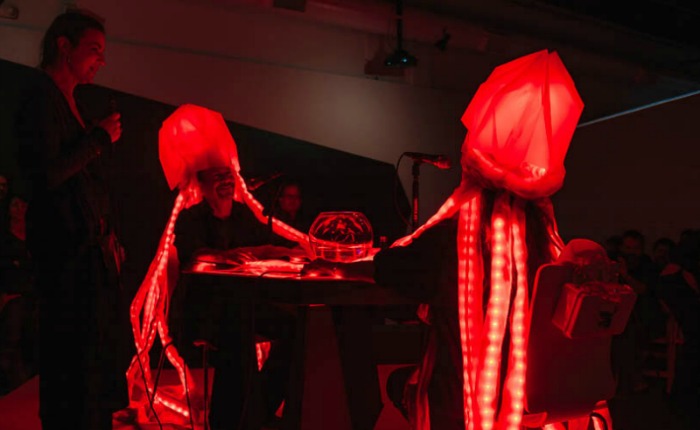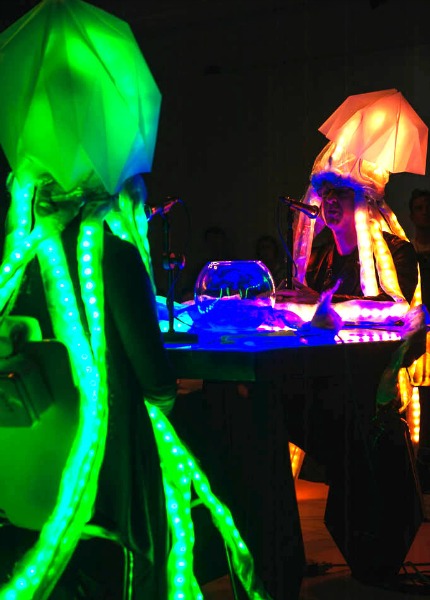Live Experiment Explores How Brainwaves React to Music and Color
The reason two random strangers might be able to befriend each other so easily at a rave may be because they’re both on the same wavelength—literally.
Last week at Los Angeles’ Sonos Studio, UCLA Professor of Neuroscience Mark Cohen and the director of UCLA’s Art | Sci center, Victoria Vesna, presented Brainstorming: Synesthesia, an interactive event that used brainwave-reading headwear to demonstrate the science behind the connection between two people when they’re entrenched in a maelstrom of sound, lights and color. These same conditions exist at many a rave.

Brainstorming: Synesthesia is part of a series of events hosted in conjunction with Sonos’ current exhibit, Sound Affects: Music and Mood. Brainstorming accompanied the exhibit by demonstrating how the combination of music and color affects our ability to connect with one another on a neurological level.
Half performance art piece and half science experiment, the event happened on a small stage in the front of the studio. Onstage was a round, acrylic LED-lit table fitted with a microphone, and a chair on either side. On the back of each chair rested an oval-shaped helmet that resembled an electric octopus. These special crowns, created by Vesna and Cohen, were programmed to change color according to their wearers’ brainwaves. The color choices were arbitrary, so red didn’t necessarily represent angry brainwaves or green calm brainwaves, but the colors did indicate specific measures of the mind’s electrical currents.
Several audience members were randomly selected to wear the brainwave-reading headpieces. Everybody offstage had a starring role in the experiment as well, as according to Vesna and Cohen, the brain activity of everyone in the audience can affect the subconscious behavior of the participants wearing the helmets, and vice versa. This hypothesis reflects Cohen’s theory that all of our brainwaves are connected and constantly playing off each other.

Color and noise were the other main mind-altering factors affecting the brainwaves of the participants onstage. Each duo was prompted to hum into the microphones and look into the eyes of their partner across. As they did, a three-piece band—consisting of two DJs and a flautist—began playing. The futuristic, ambient tones were based mostly on their personal interpretations of the colors of the two participants’ helmets and the notes they were humming. Meanwhile, on a projection screen behind the stage, esoteric charts displayed real-time data reflecting a random audience member’s brainwave patterns. According to Don Vaughn, a student of Cohen’s, such data shows that the audience matters in the experiment, as they are contributing to the atmosphere. Participants’ brainwaves would likely be different if they were alone in a room together.
From the audience, it looked and sounded like a cacophonous mess, but when I was pulled onstage to try the helmet on, I found the experience to be far more calming than it appeared from the floor.
After a few minutes of humming, talking, and laughing about how funny my partner and I looked, both of our helmets suddenly flashed an aqua hue. The fact that they turned the same color indicated that we were having identical electrical brain activity—or sharing, as Cohen called it, “a consensual experience.” This doesn’t mean, however, that we were thinking the same thing or even feeling the same emotion. According to Cohen, the process of brainwave congruency happens on a subconscious level.
While their research is still evolving, for now, Cohen and Vesna are trying to discover if such matching brainwaves are the secret to the sense of togetherness we can feel with other humans in any number of situations—whether we’re at work, stuck in traffic, or getting down on the dancefloor.
“I’m very interested in what it means for two people to become synchronous,” says Cohen. “There’s a lot of ways you can express that. We can all talk about the same thing, we can share the same experience, but we also do things with our brains that we can measure.”
Cohen and Vesna’s research may help us get one step closer to finding out the science behind what makes us get all vibey with one another at a place like a rave; but there is still more to be done.
“For me, this is pure research,” Cohen says of the project, “and it is mostly about discoveries to come.”

